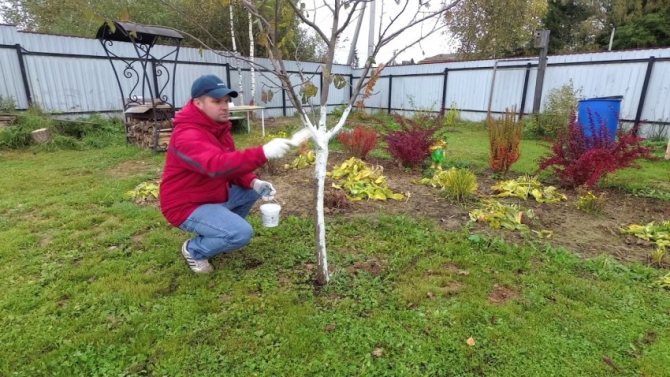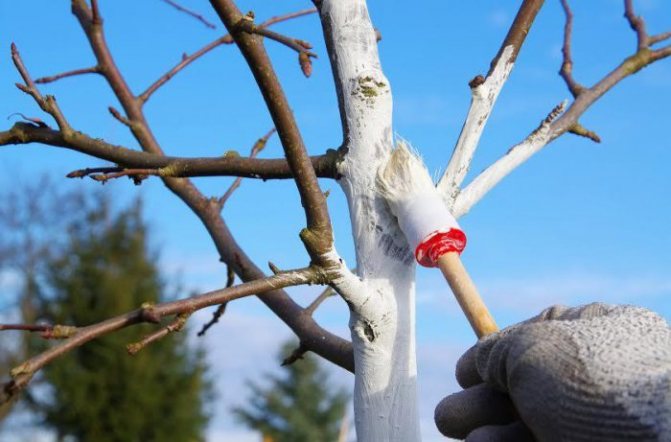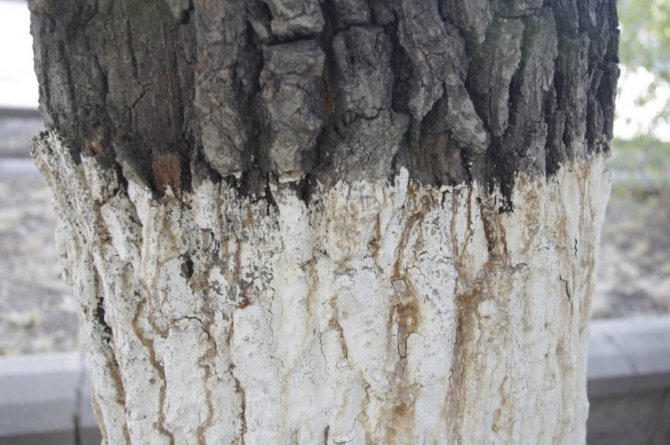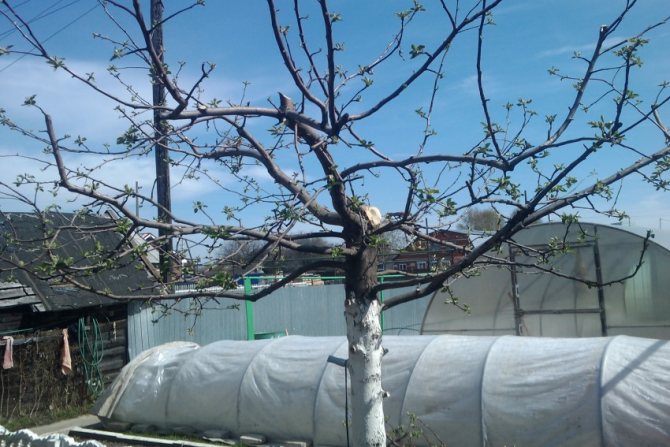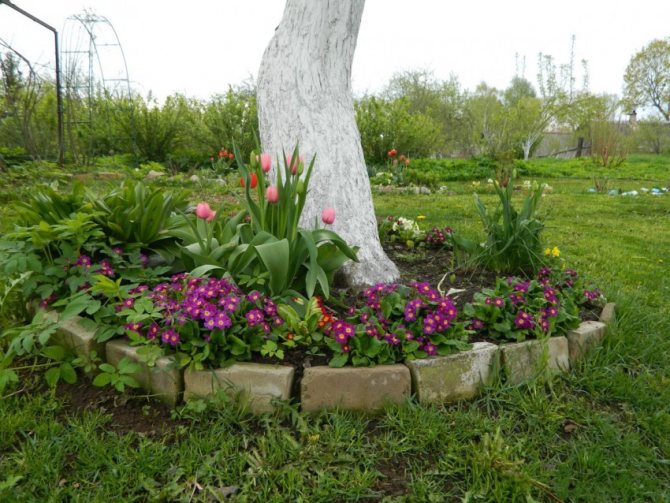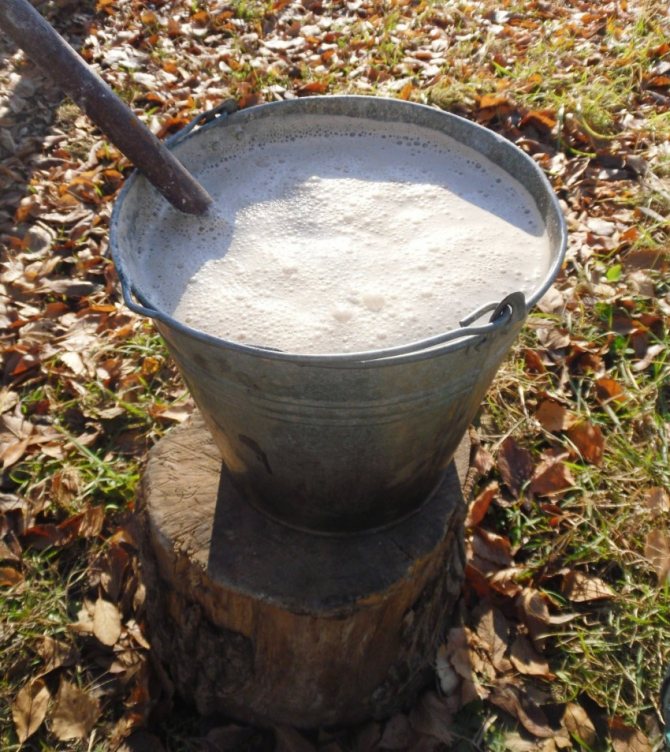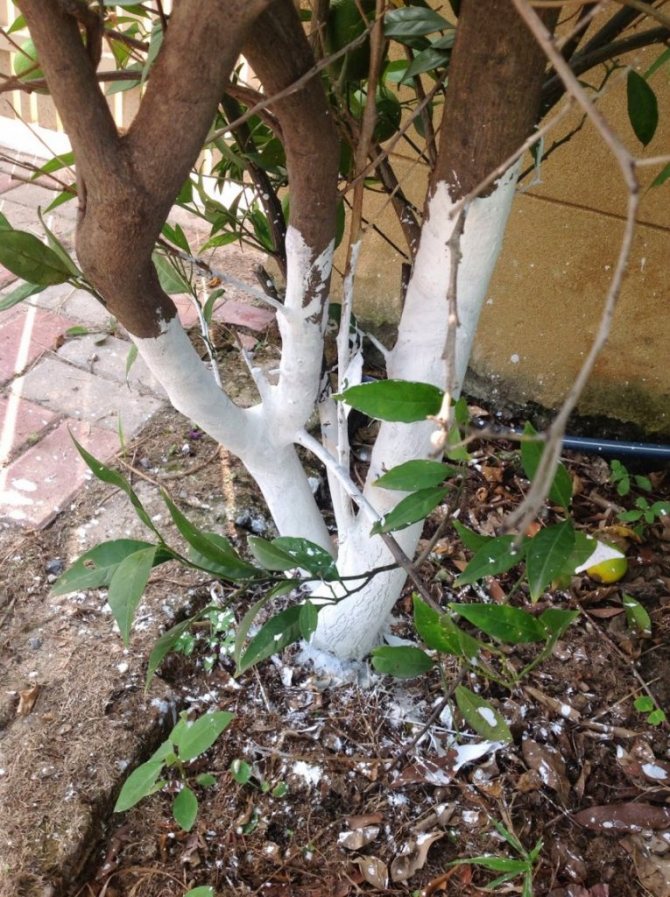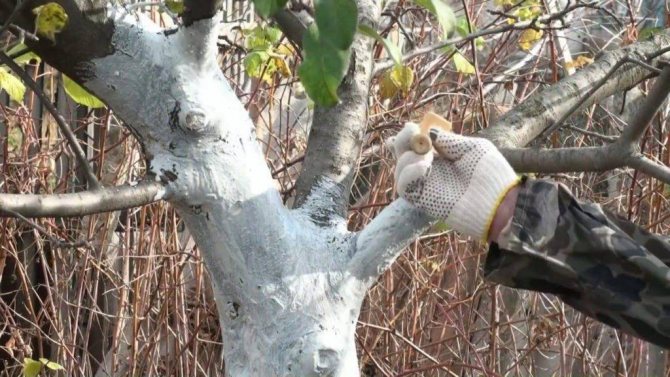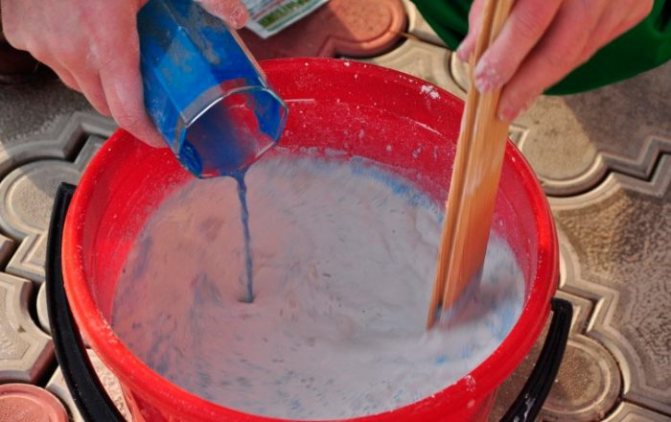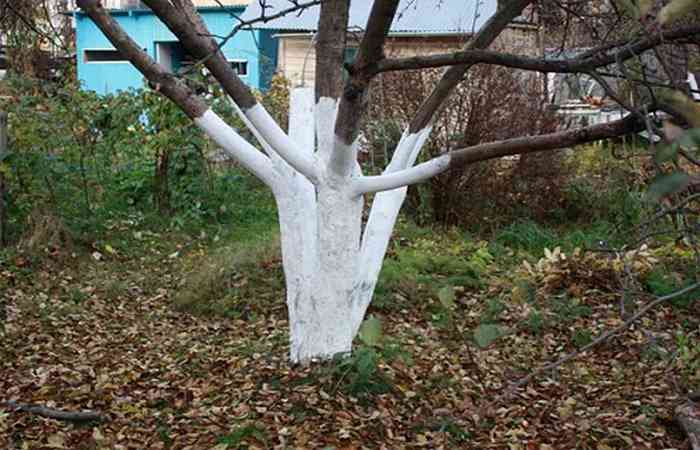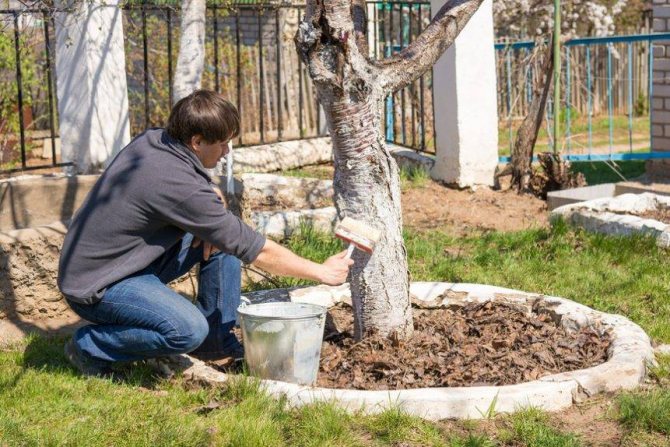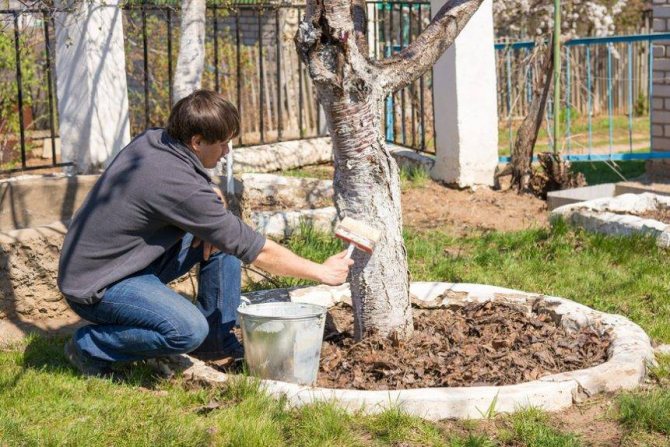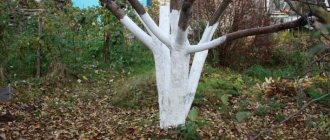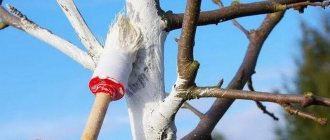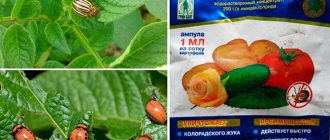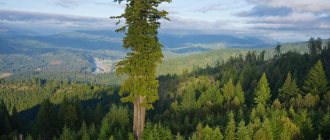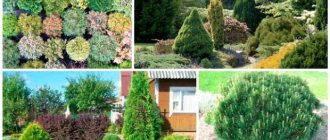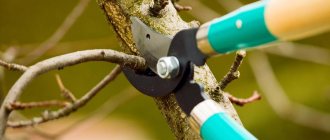Who does not like to walk in a beautiful garden, sit in its shade, admire the blossoming apple trees, cherries, enjoy the sweet gifts of fruit trees. But all this fragrant beauty requires close attention and painstaking care.
One of the rules for caring for fruit-bearing trees is painting their trunks. For some reason, modern gardeners do not all support this tradition, although these days, ready-to-use paint can be bought at any gardening store.
But many do not even know why and when. This article will tell you about why you need to whitewash the trunks, how to do this work.
Why should the trees in the garden be whitewashed?
The first reason gardeners whitewash trees is to protect them from the sun's rays, which can cause burns. However, there are other reasons that lead to the need for such work. Let's take a closer look at them.
Whitewashing is an important measure to protect trees
Protecting from frost cracks
Chills are damage to the bark of trees that look like large cracks. If you do not make a gap in time, the cracks will simply destroy the tree. They appear most often due to sharp temperature fluctuations.
For example, in summer, the temperature during the day can be about + 10 degrees, and at night it drops below -15 degrees. As a result, the bark of trees first heats up, and at night it cools down strongly. It resembles a sharp immersion of heated glass in cold water.
Thanks to the whitewash, the bark will heat up and cool down very evenly.
Pest control
The lime used in the preparation of whitewash can kill most insects, since it is alkali. But most of the diseases appear precisely because of the attack of pests. With the help of whitewashing, the risk is reduced, the consumption of chemicals is reduced, and the yield is preserved.
Protecting from sunburn
One of the most popular reasons for using whitewash is for sun protection. True, there is a lot of controversy about this, since some gardeners believe that the sun's rays can cause serious harm to the plant, while others are firmly convinced that only conifers can suffer because of this. It is quite difficult to prove someone's rightness, but it is still worth insuring yourself by using whitewash.
The need for whitewashing
Tree bark - it is an important plant organ that protects the inner layers (cambium and wood) from various external influences. Not only productivity, but also the life of any tree depends on the health of the bark and its ability to perform its functions.
Therefore, if gardeners or summer residents want everything to be fine with their trees, they must take care of their bark. In fact, it is relatively simple: since the bark is outside, the gardener always has access to it.
The bark protects the tree from the following factors:
Under the influence of these factors, the cortex itself becomes vulnerable. It cracks, breaks, erases, gets sick, etc. To help the bark cope with these influences, it must be protected.
Whitewashing is one of the main methods of protection. It perfectly copes with most of the listed negative effects (perhaps, except for vandalism), strengthening the various protective properties of the bark.
The main component of whitewashing is lime, that is, calcium hydroxide. The choice of this substance is not accidental. Due to its chemical activity, it provides excellent protection of the trunk from fungi and rodents. The white color of lime reflects sunlight, thus protecting the bark from burns.
Over time, lime absorbs carbon dioxide from the atmosphere, and its upper layer turns into calcium carbonate (which is also white and also scatters sunlight well), a thin crust of which protects the rest of the lime layer from destruction and leaching. Due to this, the disinfecting properties of lime are preserved for a long time.
In addition, such a structure has good thermal insulation properties and protects the barrel from frost and temperature changes. Due to microcracks in the upper layer, it still remains "breathing" and allows air to pass to the bark.
All trees, regardless of age, must be whitewashed. If there is a concern that the thin bark of young trees may be damaged by the chemicals used in the whitewash, there are various methods to combat this phenomenon. In order not to burn the bark, it is recommended to reduce the concentration of lime, use chalk instead, etc.
An important issue accompanying the whitewashing process is determining to what height the trunk should be whitewashed. Of course, ideally all branches will need to be covered down to foliage level. But in this case, the material consumption will be too large, and this can be done with too much time.
On the other hand, whitewashing only the trunk will not be sufficient. To ensure good safety and protection of the tree, it is recommended to whitewash at least the first tens of centimeters of the main skeletal branches. It is recommended to whitewash skeletal branches for 20-30% of their length.
back to menu ↑
Preparing trees for work - instructions
Before telling how to whitewash plants in the garden, you should conduct a short educational program on their preparation. Not all gardeners are engaged in this event, which ultimately leads to burns, despite the presence of a whitewash surface.
Important: trees cannot be whitewashed without preparing them and without disinfecting and cleaning, as this will lead to zero result.
To carry out the work, you need to do the following:
- Spread plastic wrap under the trees - this is necessary so that debris and pests falling during events do not fall into the ground.
- Take wood or plastic scrapers. Metal products cannot be used for whitewashing, as this will lead to the appearance of "wounds" on the bark.
- Examine the bark, finding cracks, cover them with a garden varnish, be sure to remove the bark that falls off, the moss.
- Prune old shoots and branches if necessary.
- Spray the wood with a disinfectant solution using a sprayer to allow the liquid to penetrate into the deepest crevices. Some gardeners use brushes for this, but this tool is not suitable for high-quality work.
- Collect the plastic, fold it carefully and burn it to prevent insects from spreading around the garden.
How to make a disinfectant solution?
It is very important to correctly carry out the treatment against diseases and pests - to disinfect the trees.
Most often, a solution of copper or iron sulfate (3-5%) is used for this. You can prepare it as follows:
- Pour 300 g of powder (for a 3% solution) into a container.
- Pour 300 ml of water there.
- Stir well and add 9 liters of water.
- Stir again.
This solution should be sprayed on the trunk and skeletal branches.In case the tree began to bloom (for example, you missed the required disinfection period), you need to prepare a 2% solution (take 200 g of powder).
Prepared mixture for whitewashing
If, when viewing a tree, you find moss or lichen on it, then vitriol will not help in this case. A saline solution will help to cope with this problem, which can be prepared from the following substances (by dissolving them in 10 liters of water):
- 1 kg of table salt.
- 600 g of urea.
- 600 g nitroammophoska.
- 300 g of potassium chloride.
- 500 g of potassium carbonate.
The prepared solution must be applied to the bark where the moss grows. You can also add it to the whitewash itself.
Some gardeners do not like to use "chemistry". In this case, you can use a more gentle solution prepared from wood ash. The recipe is simple:
- We take 3 kg of ash.
- Fill it with 5 liters of water.
- Bring the mixture to a boil.
- After the liquid has cooled down, you need to add 50 g of laundry soap, rubbing it in advance.
- Mix thoroughly.
Spray the trunk and skeletal shoots with the prepared solution. Three days after disinfection, the trees can be whitewashed.
You will learn more about what lutrasil is and how to use this covering material in our material.
you will learn about the correct choice of fertilizers for grapes.
How to fill the strip foundation formwork? We will tell you about it.
Let's summarize
- The task of whitewashing is to protect the trunk and skeletal branches of the tree from the bright sun, to prevent fungal diseases, and exterminate pests. The procedure can be carried out in autumn, winter (best in February) or early spring.
- The basic components of homemade mixtures are slaked lime or chalk, clay.
- Fungicides, mullein or manure, serum, soap (mainly household soap), glue will help to give the mixture additional useful qualities.
And the correct process of whitewashing (with preliminary cleaning of the bark from growths, pre-whitewashing and, in fact, "painting" the trunk) you will see here:
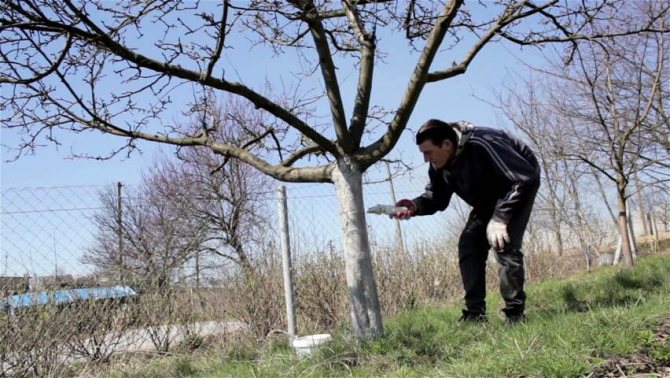
How to make do-it-yourself whitewash for trees? Many gardeners do not see this as a problem and this event is held annually, buying ready-made garden mixture at a hardware or gardening store. We will tell you how to make a do-it-yourself whitewash for trees, which would be long-term and resistant to weathering.
Read in this article:
How to dilute lime to whitewash trees?
In stores, only quicklime is sold, which is presented in the form of small stones, sand, but they all have a strong alkaline reaction. As soon as contact with water occurs, heat begins to evolve, as a result of which the following three types of solution can be obtained:
- Fluffy.
- Lime milk.
- Lime dough.
The final result depends on the amount of lime in relation to the water. But according to technologies, first you need to get fluff from the solution, and only after that - prepare a mixture for whitewashing.
When working with quicklime, be very careful, because when in contact with water, the temperature of the mixture can rise to 150 degrees Celsius, the solution begins to boil. Careless maintenance can damage your skin or burn your eyes.
The cooking recipe will be as follows:
- Take a deep bucket.
- Pour 2 kg of lime there.
- Gently pour in 2-2.5 liters of water.
- Wait for the reaction to pass.
- Stir the mixture gently.
Next, we prepare a solution for whitewashing, for which you need to take:
If you just dissolve the resulting fluff in water, then in a couple of weeks the whitewash will be washed off the trunk. Therefore, it is better to use the following solution for whitewashing:
- 2 kg of fluff.
- 10 liters of water.
- 50 g flour paste.
Mix everything and apply to the tree trunk with a brush. If you don't have a paste on hand, use 1 kg of clay instead.The solution should turn out to be creamy, because if the mixture is liquid, it will quickly drain from the trunk, and a too thick composition simply will not be applied to
Note. You should have a creamy mass (milk of lime). A thinner solution will roll off the bark, a thicker one will not stick.
Lime-based whitewashing recipes
The composition of the mixture for whitewashing the garden includes the following ingredients:
- 2.5 kg of slaked lime (fluff);
- 10 liters of water;
- a few tablespoons of flour paste.
Instead of paste, you can use other components: clay (1 kg), soap (10 tablespoons of shavings), fresh mullein (0.8-1 kg).
You need to take lumpy lime and extinguish it 2 hours before whitewashing. Freshly slaked lime works best in the fight against pests, lichens and fungi.
Whitewashing of trees with lime with copper sulfate has proven itself quite well. To prepare a suitable mixture, you should take:
- 2 kg of slaked lime (fluff);
- 300 g of copper sulfate;
- 10 liters of water.
You need to mix the components so that you end up with a homogeneous mass of thick sour cream consistency.
What is the best time to work?
We described how to prepare a whitewash solution, but it is also important to complete the work on time. It is believed that the best time is spring, but this is not entirely true. It is better to whitewash trees twice: in spring and autumn before preparing shrubs for winter.
In the spring, work should be done after the snow melts. If we are talking about the central regions, then it is better to carry out work in late March or early April. If we talk about the southern regions, then whitewashing can be carried out at the very beginning of spring. The main thing is that the air temperature does not drop below + 5 degrees Celsius. True, it is not worthwhile to delay this event - it is better to disinfect and whitewash until the leaves form.
If you hesitate, the soil will begin to warm up, insects will crawl out of it, and the whitewash will become useless.
In autumn, work is carried out after the trees have dropped their foliage, while the temperature should not fall below -4 degrees. The process is the same: first we clean off the old bark, disinfect it, process the cracks with garden pitch and whitewash the trees.
You can also carry out such events in the summer - for example, if the solution was washed off by rain. But it is better to carry out work in the early morning, and not in the heat. During this period, no preparatory work should be carried out.
Other types of pest control of fruit trees
In order for the garden to be protected from pests all year round, you should never forget about such a mandatory stage of plant care as spraying. A fruit bush or tree is best sprinkled in summer when pest activity is at its peak, in autumn after foliage has fallen, and in spring. Such measures will allow the garden to painlessly endure the frost period and prepare for the warmer season.
When to treat fruit trees from pests in the spring
Spraying fruit trees in spring before and after flowering
The first spring spraying should be in early March before the leaves begin to bloom. To do this, you need to thoroughly clean the trunk and process the bark, paying special attention to cracks, since many insect larvae could overwinter in them.
For your information! Cleansing the bark is necessary to protect the plant from burns and other damage to the bark.
Features and timing
Any garden owner knows it's time to whitewash the trees in the spring. And only experienced gardeners know that trees are whitened three times a year - in autumn, spring and summer. Features and timing of whitewashing - in the table.
Table - Terms and goals of whitewashing apple trees in different seasons
| Season | Month | purpose | Note |
| Fall | October or November | Protection from the February sun - it is especially active. Under the influence of sunlight, the trunk heats up to +9 ° C - this provokes sap flow.The sap freezes and the bark cracks. | The main whitewash, on which the health and life of the tree depends. |
| Spring | End of February - beginning of March (if the autumn whitewashing was carried out, then later - in March-April) | Protection against insects, fungus and other infections. | This is the second most important whitewashing, it is carried out as soon as the temperature permits. |
| Summer | June July | Protective functions upgrade, high temperature protection. | Summer whitewashing is especially important if in spring it was carried out with a weak solution. |
Experienced gardeners give advice on when to whitewash:
- you shouldn't whitewash trees before the rainy season;
- September is too early a month for whitewashing, trees should be whitewashed a couple of weeks before frost.
Whitewashing: rules, tricks, wisdom


- It is necessary to process not only the trunk from the bottom, but also the skeletal branches - as in the photo.
- On many sites, I saw a recommendation not to touch young trees. Dad and I have even whitewashed yesterday's saplings for years. I have never noticed that the trees reacted badly to the procedure - on the contrary, they take root even better. However, processing such trees for the first time, you can prepare a less "vigorous" whitewash, each component adding half the norm.
- Copper sulfate is not poured in powder form. It must first be dissolved in a cup of hot water, and only then poured into the whitewash.
- The ideal consistency of whitewash is like sour cream, without lumps.
- Before whitewashing, it is worth peeling off the moss and dead bark from the trunk. If this causes cuts, gently treat them with garden varnish.
And here is how a professional agronomist looks at whitewashing. In this video, he will tell you how, when and why it is necessary to whitewash the trunks of fruit trees, and in addition, he will share his opinion on the best remedy:
When to prepare and apply the mixture
My dad always said that in the spring we whitewash the trees to protect the future harvest from pests. Later I learned that the main purpose of this procedure is to protect against the sun, which is strongly intensified in February-March. During the day, the luminary heats up the trunk, as a result of which juices begin to move along it. At night, when frosts still reign, the whole thing quickly freezes, and the bark can burst.
This gardener is also sure: it is too late to start gardening in spring, the correct time for processing trees is February. And that's why…
Preparing an apple tree for whitewashing
Before you take up a brush and a bucket of lime, you need to properly prepare the trees for whitewashing. Preparation consists of three stages, the fourth is the direct application of the coloring composition.
Watch a video on how to prepare an apple tree for whitewashing:
Barrel cleaning
The trunk must be freed from large branches. Optimal conditions for cleaning are high air humidity. The trunk is cleaned of lichens, growths, flaking bark. Cleaning is carried out with a wooden spatula. All litter is collected and burned to prevent the spread of infection and pests hiding in the bark. The best time to clean is after rain.
When cleaning, it is not recommended to use a saw, metal brushes, scrapers and scouring pads.
Disinfection of wounds
Held in dry weather. Moreover, the next three days should also be fine - otherwise the expected effect will not be. There are 3 types of disinfection:
- Capillary processing. The barrel is sprayed with a mixture of copper sulfate and Bordeaux liquid - from a spray bottle.
- Ash and soap processing. A solution of ash and household soap is applied to the trunk with a rag. The solution is prepared in hot water. Laundry soap (50 g) and ash (3 kg) are dissolved in it.
- Spraying. It is carried out with a saturated ash solution.
You cannot use a solution of copper / iron sulfate every year, since copper and iron can accumulate in the bark and soil. High concentrations of these elements threaten the tree - its immunity decreases, the tree gets sick and dries up.
When disinfecting the barrel, precautions are taken - they work with gloves and a respirator.
Putting the wounds
After cleaning, there are grooves on the barrel, which are sealed with putty, paste or clay mash. To prepare a chatterbox, take clean clay (200 g), manure (100 g) and straw dust. The components are diluted with water to a sour cream consistency. All damage on the tree trunk is smeared with this talker. You can buy ready-made putty in the store - for example, RanNet paste.
Four stages of whitewashing
Stage one: manual cleaning of branches and trunks
You will need cloth garden gloves to complete this step. In no case should you use metal brushes or scrapers to clean the bark. These tools will only further damage it, instead of cleaning it, destroying it.
You can use a sharp splinter to clean the cracks. It is necessary to remove hibernating pests, vectors of woody diseases, to clean the stem and lower branches from overgrown lichen and moss. All this must be burned.
Stage two: disinfecting the bark
For disinfection, use 0.3 kg of copper sulfate powder, diluted in 10 liters of water,
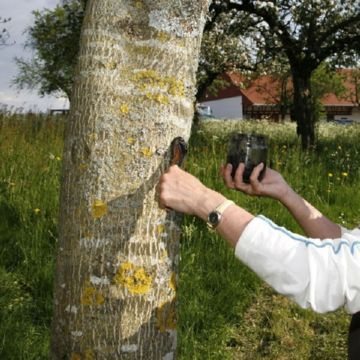

or ferrous sulfate (0.6 kg per 10 l of water) You can use other copper-containing compounds, for example, "HOM", "OXI-HOM", "ABIGA-PIK".
The bole and branches are sprayed so that the disinfectant does not flow down in streams. Usually use finely dispersed method, in which the smallest drops of the disinfectant composition envelop the tree trunk, evenly settling on it. Often it is impossible to do such disinfection: the accumulated metal will adversely affect the condition of the plant.
There is another version of the disinfection solution, made from 2 kg of ash and a bar of laundry soap, which are diluted in 10 liters of hot water. Such a composition in a warm form is applied with a rag or a herbal bunch on a stem. Ash is a disinfectant for the plant and its feeding at the same time.
Stage three: patching up cracks in the bark
For this, special putties are used, which can be found in gardening stores or prepared by yourself. Here are some recipes:


- A chatterbox is prepared from pure clay or mixed with lime, copper sulfate and manure. Dilute the mixture with water until sour cream is thick.
- You can cook your own garden var. To do this, in turn, 100 g of rosin and 200 g of real beeswax are melted; then they are mixed, 100 g of melted fat are added, poured into a container with cold water; taken out of the water and rolled into a lump. You can store such a putty for a very long time, slightly warming it up before applying it for elasticity.
- The RANNET putty already contains copper sulfate, so additional disinfection is not required. Such a paste perfectly heals wounds on a tree; it is also used to treat cut sites. Ready-made pasta is commercially available.
Stage four: applying a whitewash solution
After completing the previous three steps, you can start painting. Usually the stem and lower branches are whitened by one third or half. On average, the height of the whitewash coating depends on the height of the tree, reaching one and a half meters. There are several rules:
- to apply lime, use a wide soft brush so that you can get to hard-to-reach places;
- the thickness of the whitewash layer should not exceed 2-3 mm: a thicker layer will crack and crumble when dry;
- if the lime color turns gray upon drying, you need to apply another layer of white, achieving a pure white color;
- it is imperative to whitewash the trunk slightly below the surface of the earth, for this you need to slightly rake the earth around it, and after the layer of whitewash has dried, fill the earth back.
A controversial attitude among gardeners arose to painting seedlings. Some believe that the lime will burn their tender young shell. Others say that the harm from sunburn and frostbite will be much greater than from lime treatment. To avoid this, a composition with a concentration of 2 times less than for ordinary adult trees should be used.
Compositions for processing
For whitewashing, you can use lime mortars, prepared independently, or bought ready-made. To stain the trunk, use:
- Lime mortar is the cheapest and most popular option. The downside is the low degree of protection. Add dung, clay, or glue. Two rains are enough for the whitewash to come off the trunk.
- Paint (water-based or acrylic). Usually, antifungal drugs are injected into it, creating a protective film around the trunk. The disadvantage is that the paint "does not breathe". Only mature trees are whitewashed with paint.
There are many compositions used for whitewashing, their main characteristic is the presence of three main components:
- white dye;
- viscous adhesive component;
- disinfectants.
Consider what substances are used to whitewash apple trees, and what compositions are prepared based on them.
In the next video, the gardener will tell you how to paint the trunk of an apple tree:
Pure lime
Lime is the most popular whitewashing agent for trees. It is easy to breed, non-toxic, and cheap. Trees are whitened with slaked lime, it is also called fluff. This lime is sold in the form of a paste or powder. You don't need anything but cold water to breed fluff.
Clay
In order for the lime to stick better to the trunk, clay is added to it. It is impractical to whitewash a tree with pure lime alone; without viscous substances, it is quickly washed off by rains. Clay is one of the available viscous substances that are used to prepare lime compositions.
Clay not only helps to fix the whitewash on the trunk, but also has good thermal insulation properties. The clay composition protects trees from overheating and hypothermia, as well as from the effects of winds. An important plus of clay is that it does not close the pores and does not interfere with "breathing".
Mullein
Mullein or liquid manure is a natural organic fertilizer. It is used not only to increase the nutritional value of the soil, but also to whitewash trees. Thanks to this ingredient, the whitewash becomes more sticky, it is qualitatively fixed on the bark. In addition, mullein is a source of trace elements that feed the tree.
Paint
Instead of lime, it is permissible to use paint:
- Water-based. It protects the tree trunk like lime - from sun and frost. The paint lasts longer than mortar, so the amount of whitewashing is reduced.
- Acrylic. The advantage of painting with paint is that you do not need to prepare a solution, just open the can and start painting.
Paints allow air to pass through, but they retain water in the bark - they do not allow it to evaporate. The main drawback of the paint is its unnaturalness, it is even safe, but still "chemistry". The second minus is its cost, painting trees with paint is more expensive than lime.
Standard whitewash composition
A standard whitewash consists of three ingredients:
- quicklime - 2.5 kg;
- water - 10 l (bucket);
- clay - 1 kg.
The main function of the standard composition is to destroy insects and protect the apple tree trunk from harmful effects. Lime is taken about twice as much as clay. Cooking procedure:
- Lime is quenched with water. For the preparation of lime dough for 1 part of lime, take 1-1.5 parts of water, and for lime milk - 3 parts of water.
- Clay is added to the cooled solution and the mixture is thoroughly mixed - it should have the consistency of sour cream. A thicker solution will create a thicker layer that will not be washed away by the first rain.
- Clay can be replaced by glue - casein or wood.
When working with lime, observe safety measures and accuracy - when it interacts with water, the quenching temperature reaches 150 ° C.
Burn protection
This composition creates a shiny layer on the trunk that reflects the sun's rays well. The composition is prepared from:
- lime - "fluff" - 300 g;
- water - 2 l;
- PVA glue - 2 tbsp. l.
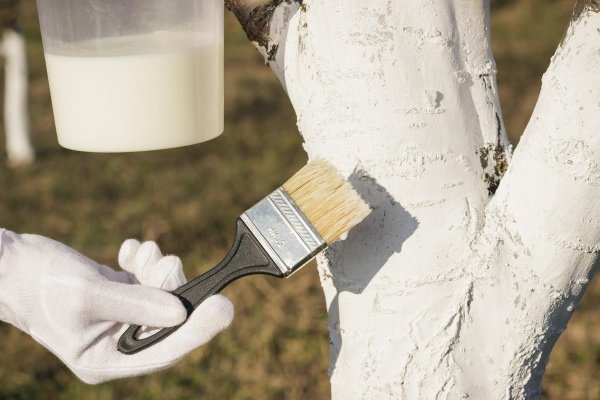

Protection against rodents, hares, ants and fungi
This is a universal composition, destroying pests, it serves as an effective prevention of rot. The composition is prepared from:
- PVA glue and PVA dispersion (1: 1) - 125-250 ml;
- water - 2 l;
- vitriol of iron / copper - 2 tbsp. l.
Thanks to vitriol, the composition will protect the tree from diseases and fungi. And if you add "Knockdown" to the composition - a few drops, or a little Creolin, then the composition will scare away hares, mice and other rodents. Such whitewashing destroys fungal spores and all ant eggs hidden under the bark.
The prepared solution is thoroughly mixed and left for half an hour. After re-mixing, proceed to whitewashing.
Store samples
Store whitewashing is convenient in that it does not require preparation. I opened the lid, took a brush, and you can paint right away. Whitewash sold in stores differ in composition. They are lime, acrylic, with the addition of clay, vitriol, silver, and other additives.
The most durable store-bought whitewash is acrylic. More natural - lime-clay, allowing the bark to breathe. But lime shop whitewashing has serious drawbacks:
- the need for reapplication;
- fragility - easily washed off by rains.
Most store-bought whitewash is applied with a brush. But it is much more convenient to use aerosols - a liquid released under pressure gets into the most inaccessible places without any effort on the part of a person.
Store Whitewash Samples:
- GreenSquare (PKF Palisad) - acrylic composition;
- Robin Green (Fasco LLC) - silver biomask;
- Gardener (LLC Fasco) - lime whitewash with copper sulfate;
- Lime whitewashing with copper sulfate (PKF August) and others.
After testing the garden whitewash, it was concluded that the most resistant store compounds are acrylic. They make the surface snow-white, shiny, and provide high-quality protection from the sun. After winter, the paint does not crack or wash off - if the tree is whitewashed in autumn, the spring whitewashing can be skipped.
The main components of whitewash garden
Slaked lime (vapno)
Classics of the genre! Some people simply pour lime with water and whiten trees with such a simple means.
What does lime give? Once on a tree, it turns white, due to which it reflects the bright spring sun rays, preventing them from burning the trunk. You need lime and other white components if in the spring the bark is covered with dry particles or cracks all the time. This is what burns look like:


It is worth using lime in autumn, winter, or at least early spring.
Here's how to properly slake lime:
By the way, there is also an opinion that modern pests are not too afraid of this substance, so high-quality disinfection with lime will not work. I agree: personally in our garden, after whitewashing only with lime, the number of worm apples and fungal diseases does not decrease.
First, it also reflects sunlight. Secondly, its composition is softer than lime, so it is better suited to the delicate trunks of former seedlings.
But chalk also has a significant drawback: rains and other precipitations wash it off very quickly, so it cannot withstand competition with purchased whitewash or paint (unless at a cheaper price).
Clay
It gives the solution a viscosity, so that it sticks better to the bark. In addition, thick clay well closes wood "sores" (cracks in the bark and the like), thanks to which during whitewashing you will be able to prevent fungal diseases and prevent insect larvae from entering the bark.
White clay protects a little from the sun (but not better than chalk, because it is still not snow-white). But more often gardeners use the more affordable yellow. I would recommend lightening it with chalk.
Fungicides
They are added for the prevention of fungal diseases.
It is especially important to use them if last season you treated trees for a problem - whitewashing with a fungicide will help you finally finish off the disease and prevent a new infection.
I think the most popular and affordable fungicide is copper sulfate. If he's not at home, I look at what's left from last season. Suitable ferrous sulfate, Bordeaux mixture and more complex preparations such as "Hom", "Kurzat", "Oxyhom".
An important point: when diluting the fungicide, always follow the instructions (even if the sachet is hopelessly torn, the instructions can be easily found on the Internet). Overdosing can harm the tree even through the bark.
Glue (different composition)
This substance also helps the whitewash become more sticky and last longer.
The composition of the glue can be different: PVA, wallpaper, carpentry and even casein (I like the latter most of all, as it is natural and environmentally friendly). The worst thing on this list is PVA - it clogs the wood, preventing it from breathing.
Adding this substance, it is better not to report a little than to "bang" too much, because any glue can clog wood pores.
Soap (mainly household soap)
On the one hand, soap also increases the stickiness of the whitewash, moreover, it is not so dangerous for wood. On the other hand, a couple of rains, and this substance will wash off perfectly without a trace.
Many yards use a cheap bar of laundry soap. It can be grated quickly on a medium grater and diluted in warm water.
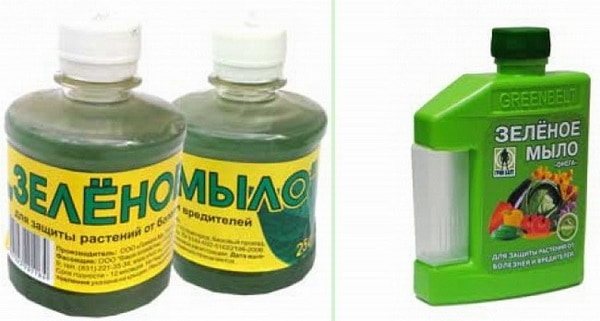

But if you look into a store for gardeners, gardeners or florists, you can find green soap there (it is produced by different manufacturers, and it is sold in Russia, Ukraine or Belarus). This liquid substance, in addition to stickiness, has other useful qualities: it heals plants from diseases and drives away pests. So if you decide to use it, copper sulfate and other fungicides do not need to be added to the whitewash.
Other less popular components
- Manure. Not everyone knows, but this substance also helps the whitewash adhere better to the wood. In addition, manure (if it grinds well) acts as an excellent antiseptic. And of course, do not forget about the mass of "tasty" microelements contained in it.
- Whey and milk. Another ingredient thanks to which the whitewash becomes, if not indelible, then the most durable. This natural remedy is multifunctional: it nourishes the tree, kills pathogens of fungal diseases and dangerous microbes.
- Carbolic acid. This substance has a specific purpose: its pungent smell scares away rodents. Therefore, if your apple trees are gnawed by hares or mice in winter, treat the trunk with whitewash with carbolic acid in the fall. In addition, small nasty people do not like the taste of chalk and lime, so even if you could not buy this acid, do not refuse whitewashing.
Also, some gardeners highly praise the oil-based white paint. It is used neat or mixed with the ingredients listed above. This component allows you to create a leave-in solution that will stay on the barrel for up to 6 months.
True, not a single agronomist with whom I happened to communicate confirmed the benefits of such a component. And even more than that: they said that the paint is too dense, prevents the tree from breathing. So I don't use it and can't recommend it.
Step-by-step instructions for whitewashing an apple tree
The main condition for whitewashing is dry weather. In order for the procedure to be useful, the lime solution must dry thoroughly and fix on the trunk. The brush is selected taking into account the volume of the trunk - the older and thicker the apple tree, the wider the tool is taken. The largest trees are easier to paint with a spray gun - thanks to it, the solution will fill all the cavities, evenly distributed over the surface.
The solution is applied with a layer of 2-3 mm. The thicker layer cracks and falls off the bark.
The whitewashing procedure is the same at any time of the year. Step-by-step instruction:
- Prepare a working solution and leave it for 2 hours. If whitewashing is to be done with finished paint, open the container.
- Wear a respirator, gloves and work clothing.The coloring liquid should not come into contact with the skin.
- Stir the solution thoroughly - it should have a uniform consistency, without lumps.
- Remove the soil layer in the near-trunk circle - 4-5 cm.
- Begin to whitewash the tree at a distance of 1.5-2 m from the ground. Painting over the trunk from different sides, move down evenly. Paint the skeletal branches along the way - 20 cm from the junction with the trunk.
- Whitewash the trunk at the bottom, going 4 cm below the soil level.
- When the solution dries, return the removed soil to the trunk circle.
Features of whitewashing old and young apple trees
When whitewashing, the age of the tree is taken into account - the choice of the coloring composition and its concentration depend on it. What you need to know when going to whitewash young or old trees:
- Very young seedlings are not whitened, they are simply wrapped in sacking for the winter. A full-fledged, three-time whitewashing is carried out when the apple tree begins to bear fruit.
- The paint can even be applied to young trees - they do not harm the bark.
- It is not recommended to whitewash young trees with lime - it can damage the delicate bark. Whitewashing very young trees can only be done with a gentle chalk solution - lime burns the tender young bark. For 10 liters, take 1 kg of chalk. For older trees, a lime composition is prepared with a reduced rate of lime - it is put in 2-2.5 times less than for a full-fledged adult tree.
- Often in the literature it is written that it is better not to whiten young trees - so that their bark does not burn the lime. But experienced gardeners advise - even the youngest trees should be whitewashed, since the sun's rays can harm them even more. For young animals, it is recommended to use a chalk composition.
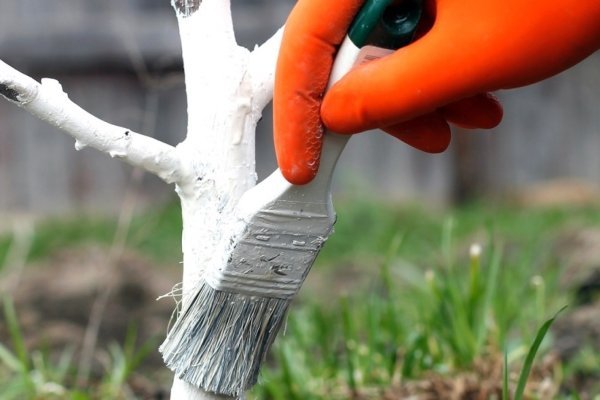

The composition of the solution for whitewashing the youngest seedlings:
- chalk - 300 g;
- water - 2 l;
- copper sulfate - 2 tbsp. l .;
- stationery glue - 200 g;
- karbophos or urea - 20-30 g;
- clay - 200 g.
Useful tips from experienced summer residents
Recommendations from experienced summer residents will not be superfluous for you. How should the procedure for whitewashing trees be carried out and how:
- A wide and soft brush can be perfect as a tool for this work.
- Each summer resident chooses the height of the tree trunk processing individually. As a rule, it will depend on the type of culture and its age. Typically, the height is 2 meters for mature trees. On a young tree, the trunk is painted but the lower branches
- The layer covering the bark should be no more than 3mm in thickness. This thickness is the most optimal. After complete drying of the tree trunk, it will not produce cracking and shedding.
- The color of the application must be completely white. It should not be gray or dark. Without the whitewashing procedure, the tree will be susceptible to sunburn and frostbite. In the daytime at the end of February, the sun begins to warm up the trunk so that the tree wakes up from winter and sap begins to flow in it. New frosts begin to freeze the juices that have sat down to rise. As a result, the tissues begin to tear and frost holes are obtained - elongated tears on the trunks.
- The bright, white color, starting to repel the sun's rays, does not allow the tree trunk to start awakening and warm up ahead of time. Without the necessary protection, the bark simply begins to become rough, coarse, exfoliate and crack. These injuries after getting infected and insect pests result in a sober decrease in the immune properties of the plant, diseases, and even premature death.


A small note! Young trees should not be whitewashed. These works must be started when the smooth bark of the trunk begins to become covered with plates and cracks.
The whitewashing procedure is not a decorative event. This is a preventative measure to protect your own crops! Plants will respond to these procedures with a healthy appearance and condition. They will be able to give a good, bountiful harvest.
{SOURCE}
Popular bugs
Many gardeners do not delve into whitewashing in particular. Once they see how this is done, they repeat the procedure from year to year, not even suspecting that they are doing something wrong. In order not to make mistakes, and not to waste time and money, read the whitewashing rules in advance.
Typical mistakes gardeners make when whitewashing apple trees and other garden trees:
- Excessively thick solution. Gardeners obviously think that the thicker the composition, the thicker the layer will be, and the better the protection will be. In fact, a thick layer negatively affects the development of the tree, moreover, it is prone to cracking. But the liquid composition is not good either - it just flows down. It is necessary to find a balance, and prepare a composition of the optimal consistency - similar to sour cream.
- Whitewashing on a bad day. You cannot whitewash trees if there is high humidity outside. Even if you have already appointed a whitewashing day, reschedule it. At high humidity, the solution will not dry well and flow down, and if it starts to rain, then all the work will go down the drain.
- Exceeding the lime rate. If you transfer the lime, the bark will be burnt. Young trees should be whitened especially carefully - for them the concentration of lime is less than for adult apple trees.
- Violation of deadlines. You can't whitewash trees whenever you like. In addition to the weather on a particular day, you need to consider the timing. Spring whitewashing begins before the buds swell, and autumn - before frost. If the whitewashing is carried out in violation of the terms, there will be no benefit from it, except for decorative purposes.
- Annual use of vitriol solution. The tree receives a lot of toxins, does not develop well.
Cleaning and whitewashing the trunk is an important event, on the correctness and timeliness of which the growth and development of the tree depends. By performing these simple and affordable agronomic techniques 2-3 times a year, you will protect your garden from weather risks and other troubles.
The main components of mixtures for whitewashing
Before you start conjuring over a bucket of water, adding the ingredients indicated in the recipe to it, it is worthwhile to understand what function this or component of the whitewash mixture performs. This will greatly simplify the process of making "talkers" and will allow you to use those products that are currently at hand. And most importantly, you can always change the composition of the mixture at your discretion, adding only those ingredients that your garden will need in each case.
Slaked lime
Slaked lime is perhaps the most important component of a homemade mixture, since it allows you to paint it white in a simple way. The whiteness of the "chatterbox" is not necessary at all to give the garden an aesthetic appearance, as inexperienced summer residents believe. The whitewashed bole and lower skeletal branches (the basis of the tree "skeleton") will reflect the sun's rays and will be reliably protected from burns.
Lime turns the mixture white
Garden crops are especially in need of such protection in winter and early spring, when they are deprived of foliage, which protects from direct sunlight in summer. That is why "scientists" urge us to focus on the autumn whitewashing of the garden and repeat the procedure in late winter or early spring.
An alternative to lime can be chalk, which also allows you to achieve a snow-white shade of the working mixture. In addition, this natural product is softer than lime and is the most suitable option for whitewashing young trees. Chalk solutions are more quickly washed off by sediments from the bark than purchased whitewash paints, so chalk is a less reliable assistant.
How to extinguish lime to whitewash trees?
18 May 2020 ditim
Buying a ready-made garden whitewash for trees is expensive, we learned this from our own experience. In addition, it contains the same lime plus a small amount of binders. Garden whitewash and fluffy lime have a big disadvantage in that solutions based on them are quickly washed off the trees.Experienced gardeners and gardening handbook authors recommend using quicklime. Solutions based on it are thicker and more persistent.


Also, to increase the viscosity of the solution, casein or carpentry glue, clay are added to it. And as a fungicide - copper sulfate. This was discussed in the last article: How to dilute whitewash for trees?
Many do not know how to extinguish lime to whitewash trees, in what proportions to dilute in water ... To be honest, we did not know either and did not try to extinguish it ourselves. Therefore, we turned to reference books, videos and read the instructions for use on the packages. In the coming autumn or next spring, we will definitely prepare a solution for whitewashing trees already from quicklime and post a photo report of what happened (this year everything has already been whitewashed with garden whitewashing). In the meantime, we share information:
Source of information: video on youtube
- Pour a package of lime weighing 3 kg into a bucket (metal or enamel), pour 8-10 liters of water, mix. The lime starts to "boil", so the bucket heats up. You need to wait 40-60 minutes for the heating and quenching process to stop. As soon as the bucket cools down, you can use lime for whitewashing, as well as add various additives to it: vitriol, mullein, clay or glue.
- Pour lime into a clean enamel container and add the required amount of water. Wait until the lime is completely slaked (2-3 hours). It is important to take precautions and work with personal protective equipment.
- According to another instruction, pour 3 kg of quicklime into a 10-liter metal bucket and pour 4 liters of water. Blanking time: 24 hours. Then the prepared lime dough is diluted with water until the desired consistency is obtained.
The last instruction seems to us more sensible, because as a result of extinguishing, a very concentrated and thick solution is obtained. It will be difficult to whitewash trees with such a composition, so it is best to additionally dilute it with water to the desired consistency.
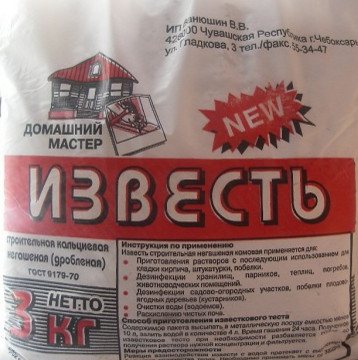

To know where you are going, here is a video showing you how the lime slaking process takes place. Lime boils, boils, therefore, it is imperative to use protective equipment (gloves, masks) !!!
A solution of quicklime (freshly slaked) lime is considered more effective for whitewashing fruit trees, and the savings are obvious!
Horticultural shops also sell slaked fluff lime. According to the instructions on the package, 1 kg of slaked lime-fluff is poured with 1-2 liters of water, that is, mixed with water in a ratio of 1: 1 or 1: 2.
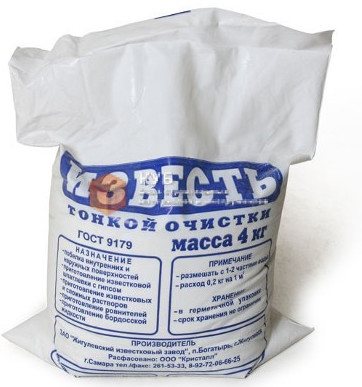

Well, garden whitewash is generally easier to plant: just pour 1 kg of whitewash with 1 liter of hot water, mix. Done!


Tags: fruit trees, garden, apple trees
Extinction rate
Lime is divided into varieties not only according to the recipe, but also according to the time of the procedure. The extinction period is calculated depending on when the temperature extinction occurs, that is, heat ceases to be generated when combined with water:
- fast pace - from 5 to 12 minutes;
- average pace - from 13 to 22 minutes;
- slow pace - 25 minutes or more.
The extinction period has a direct impact on the quality of the resulting solution, it is prepared with some differences. It is necessary to decide in advance at what rate the extinguishing will be carried out. Otherwise, the quality of the whitewash may suffer.
Quenched at a fast and medium pace
The pot is half filled with limestone and then filled to the brim with water. Lumps or granules begin to dissolve when steam appears. Stir it with a wooden stick and add some more liquid. Diluting the substance in order to obtain the desired consistency is continued even when the quenching has already been completed. It is recommended to pour the resulting composition into a working container in which it will be used for whitewashing.Lime, which is extinguished at an average rate, does not differ from that which is quickly extinguished. The proportions are also taken one to one. The difference is that no dilution is carried out until the chemical reaction is complete.
Slow rate lime
The pot or other container is also half filled with potassium oxide, and the water is poured rather slowly. When the lime has finished cracking, continue to add liquid in small portions. It turns out milk, which is gently mixed. The disadvantage of this preparation is that not all the pieces dissolve. It is quite difficult to eliminate the lumps after the end of the chemical reaction, so they are simply removed. If this is not done, firstly, the amount of "useful" whitewashing will be difficult to calculate, since the lumps will create a deceptive impression of a larger volume, and, secondly, the quality of the work carried out will sharply decrease, since the mass will not be homogeneous.
Should you whitewash trees with paint?
Water-based paints in their action correspond to whitewashing with a solution of quicklime. However, this analogue of a solution with lime is less environmentally friendly. Such whitewashing lasts a long time, however, the coating itself often simply disintegrates from temperature changes and no longer protects against pests in cracks. Therefore, gardeners often do not use this type of paint.
For experienced gardeners, acrylic paints are an excellent rain-resistant whitewash. The downside is that paint is a more expensive and less natural material. Why, then, is acrylic paint chosen by experienced gardeners?
Firstly, it adheres perfectly to the bark of trees, and therefore you do not have to worry about washing off this type of whitewash with rain. Secondly, whitewashing with acrylic paints becomes an excellent way to control pests, since substances are initially added to the paint to combat pests and pathogens.
Now it all depends on your choice, because each method has its own advantages and methods of protection against washing off the whitewash with rain.

